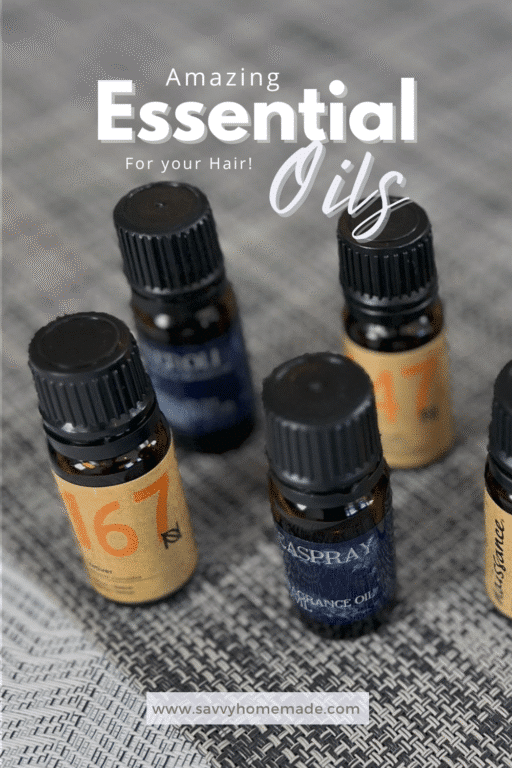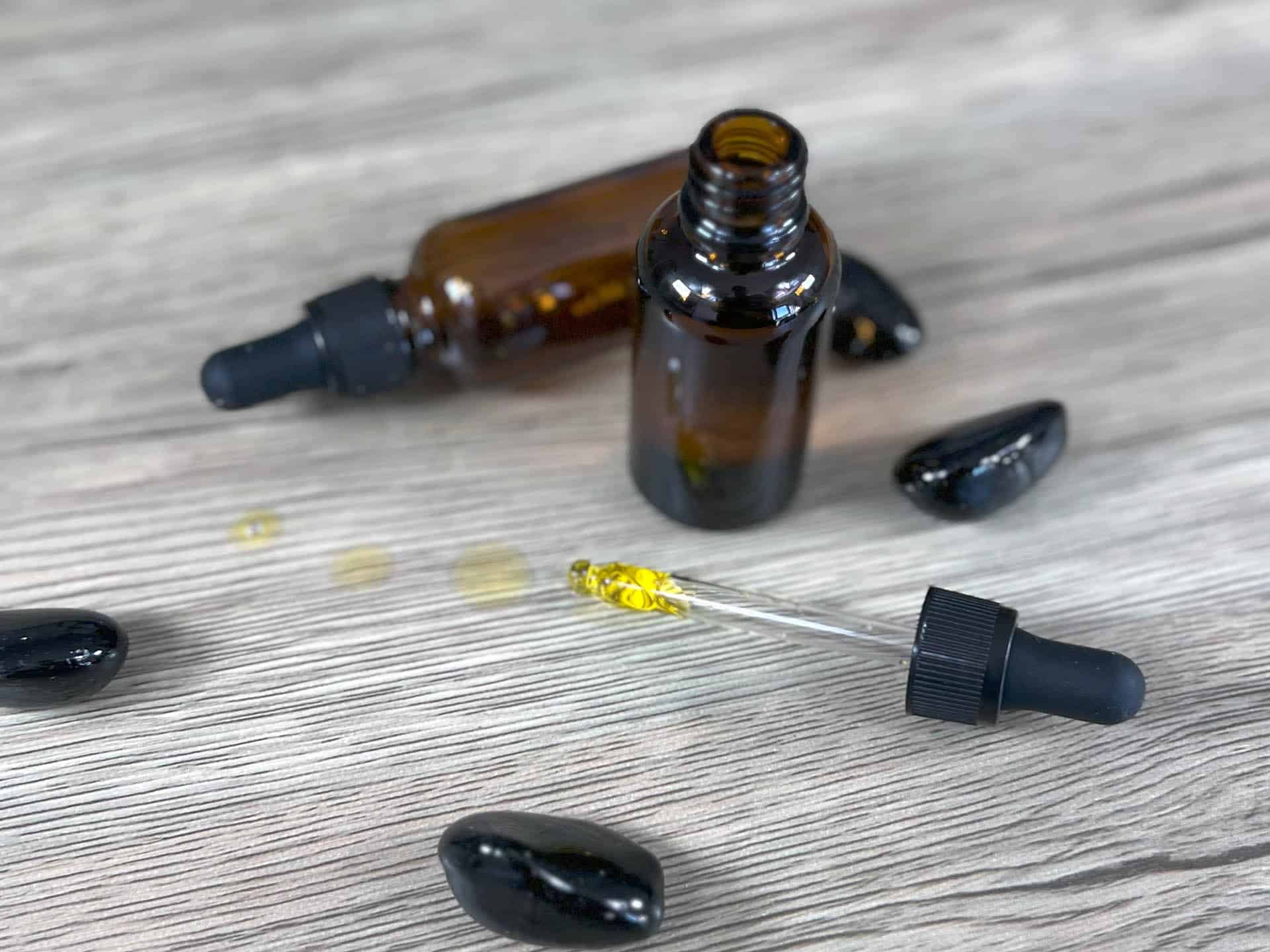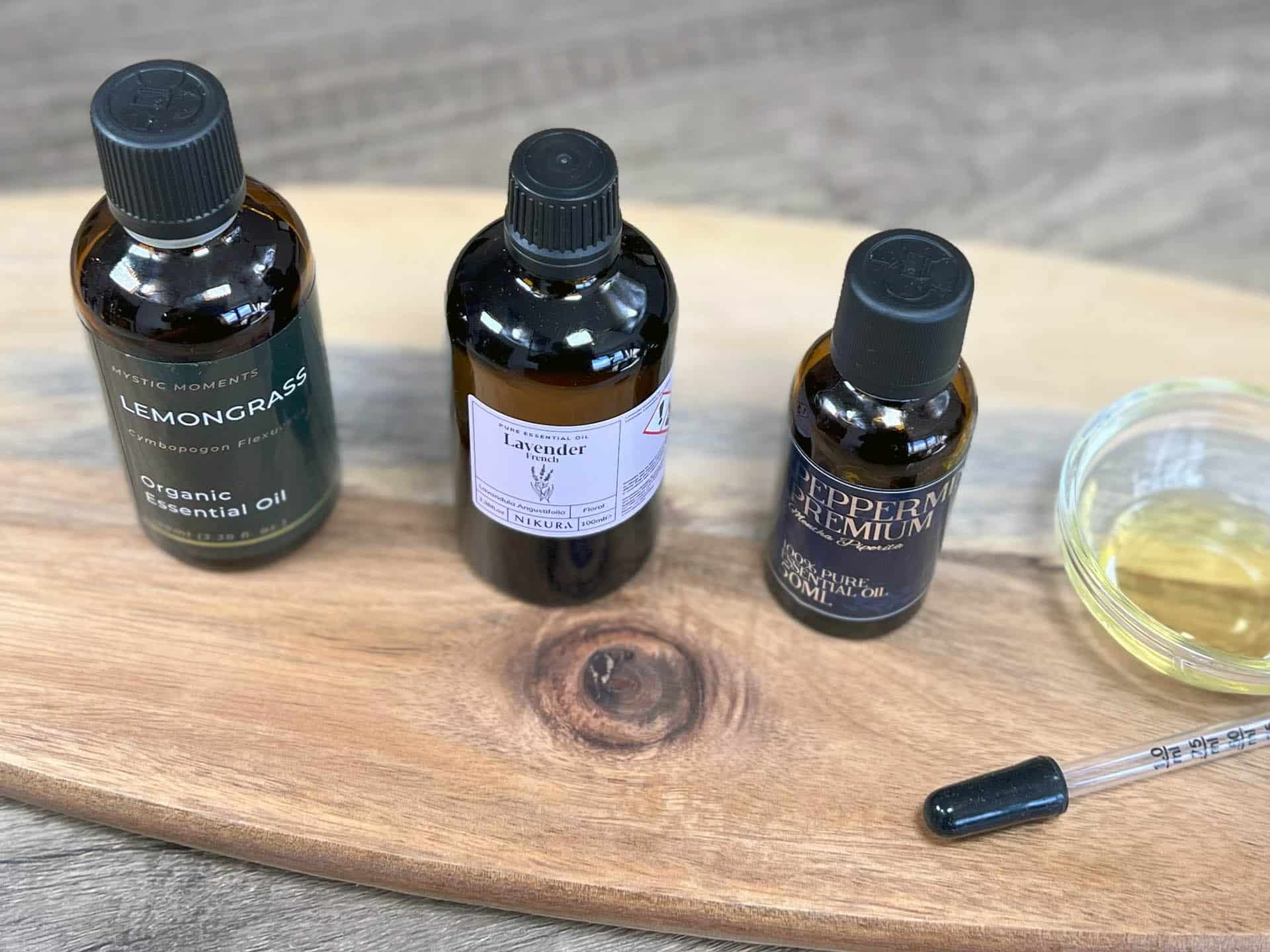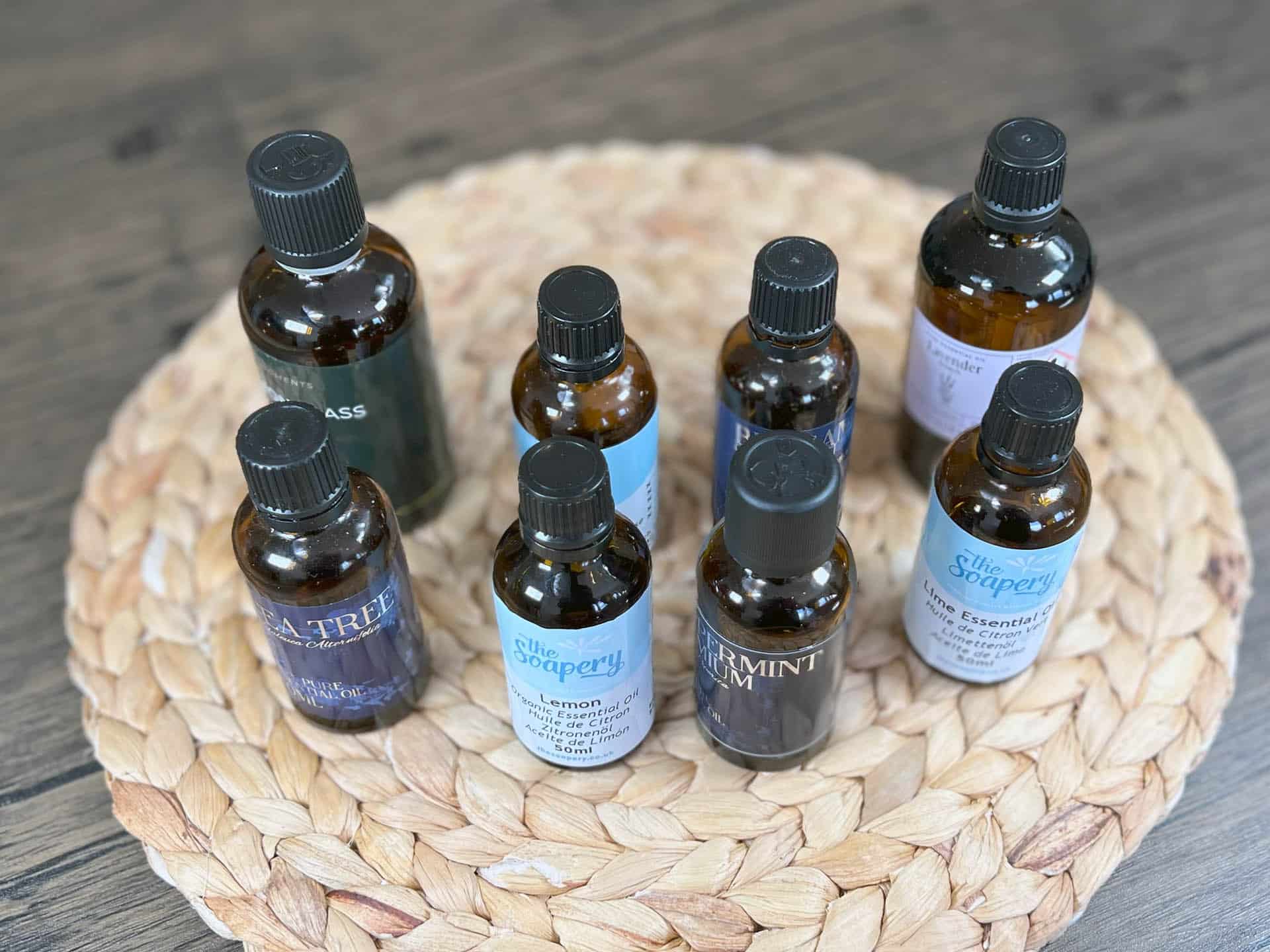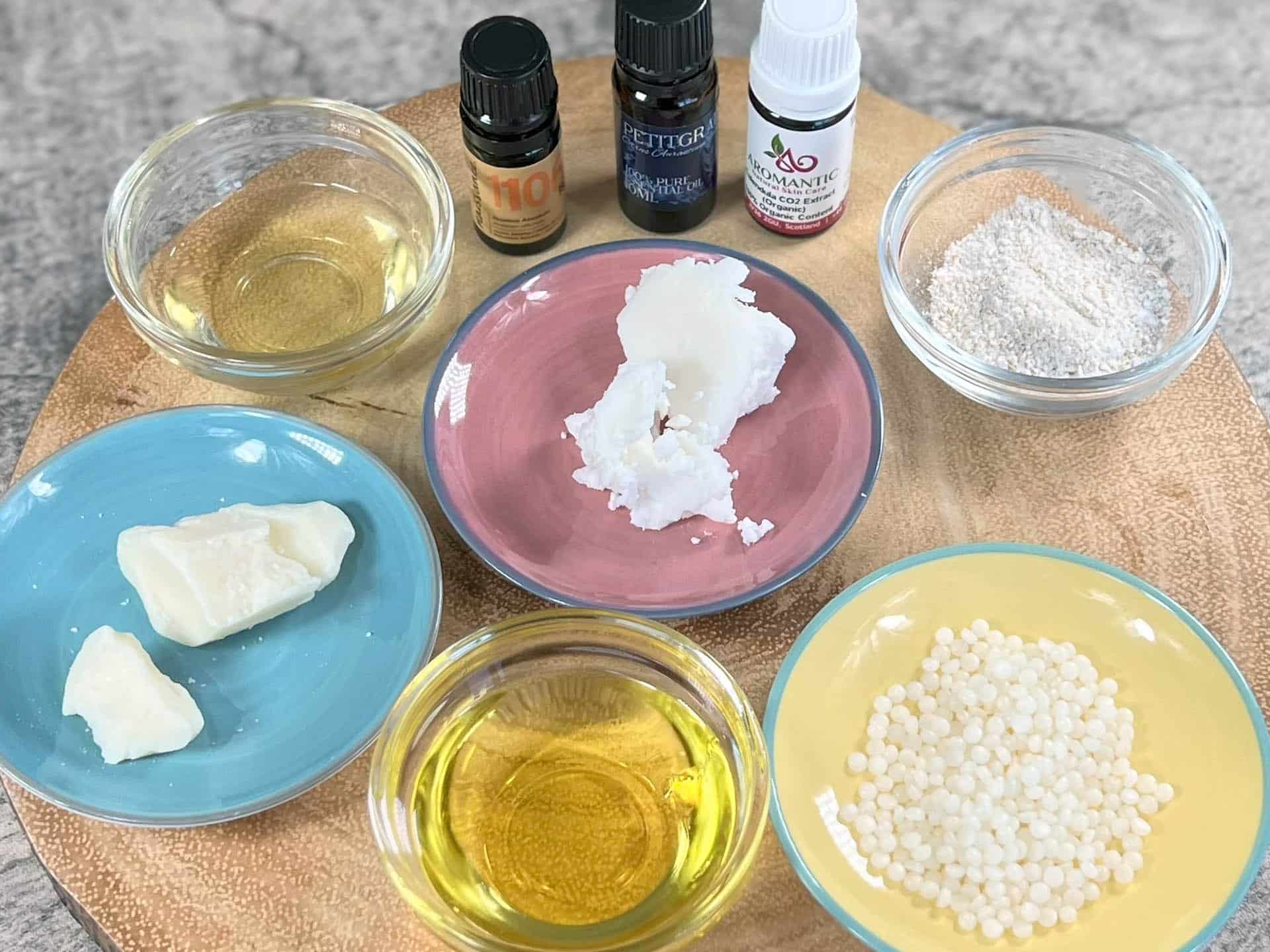If you’ve ever stared at a bottle of lavender and wondered whether using essential oils for hair care is any good. Could it rescue your frazzled ends? Maybe deeply nourish it at its core? Or even restore hair that has been lost!
I’ve been there. My own journey of using essential oil in hair care recipes started in a very human way, with a dry, irritated scalp after a winter of too-hot showers.
I reached for aromatherapy favorites because they smell lovely, sure, but also because they’re concentrated plant ingredients with real properties that can support scalp health! And by extension, hair growth and hair thickness too.
They’re super powerful, though. Definitely too powerful to pour on straight on your head. That’s the mindset for this whole piece, essential oils are natural and effective, but they deserve respect and careful use.

Before We Begin
One more quick note before we dive in. I’m a cosmetic formulator who absolutely loves loves looooves testing hair care products at home. And I’ve had a few messy moments to prove it.
The first time I mixed a peppermint scalp oil I got heavy-handed, and my head felt like it was wearing a minty helmet. Cooling, yes. Sensible, not quite. Lesson learned.
Essential Oil Benefits For Your Hair
Essential oils can support healthy hair in many ways, here’s 3 of the most important. They can promote hair growth, can strengthen individual strands and also improve scalp health. And most of that magic starts at the skin level.

Certain oils have antimicrobial and antibacterial properties that help keep dandruff in check. Others calm inflammation and encourage better circulation to follicles, which is an absolute win for anyone suffering from hairloss.
Better circulation means all those important nutrients reach the roots more efficiently, which can reduce shedding and support thicker looking hair over time. Gorgeous luscious locks, anybody?
There’s also the antioxidant angle. Oxidative stress on the scalp can affect the look and feel of your hair, so bringing in oils that have antioxidant properties can be a quiet win. Add to that the calming ritual of massage, and you get a simple practice that supports your hair and your nervous system at the same time. Tiny habit, big payoff.
What Essential Oils Are Good For Hair
The best approach is to pick oils based on a specific concern, not just what’s trending on social media. Ask yourself, what’s bugging me most right now?
- Hair growth or more hair thickness.
- Dry hair or brittle ends.
- Dandruff, buildup, or an irritated scalp.
- Flare-ups of scalp psoriasis between dermatologist visits.
- Sensitivity to fragrance or easily triggered irritation.
From there, match the oil to the need. Lavender oil is a lovely all-rounder for soothing and growth support. Tea tree oil shines for dandruff and product build up. Peppermint oil is excellent for itchy, tight-feeling scalps. Lemongrass is great when you want a cleaner feel and stronger looking follicles. Rosemary oil helps hair feel more resilient, less prone to breakage.
And please keep personal context in mind. Pregnancy and very young children require extra caution with essential oils, and some people are simply more sensitive. There’s no shame in starting slow.
Lavender Essential Oil For Hair
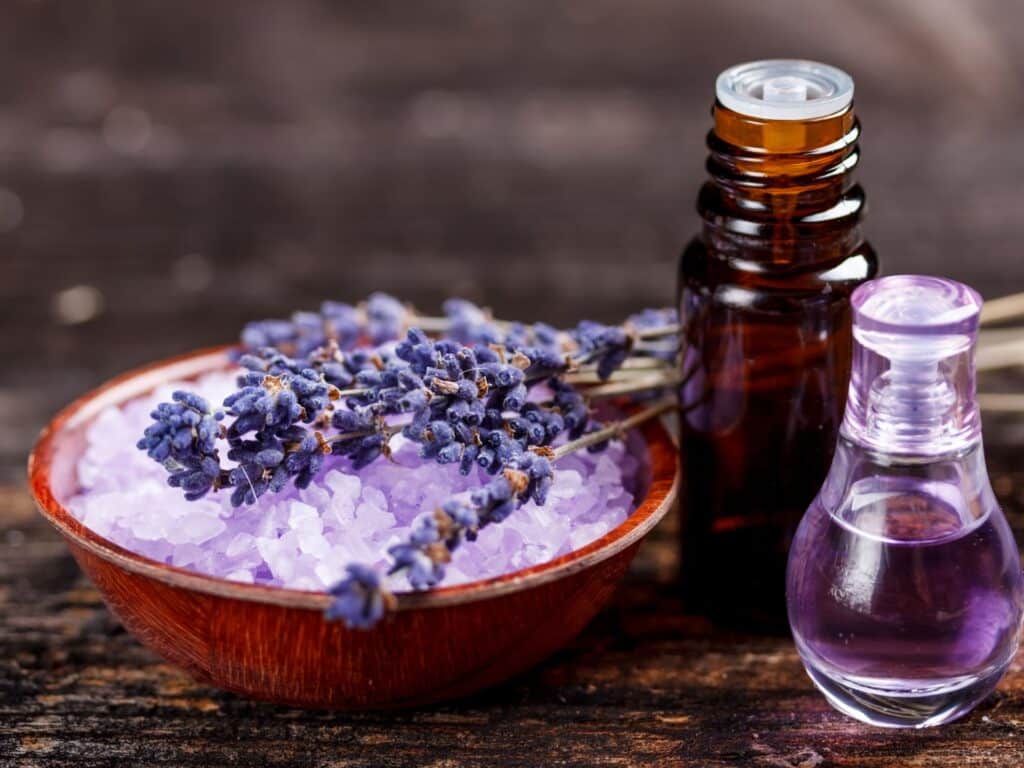
I reach for lavender essential oil when I want a gentle, steady assist. It has antimicrobial properties that make it helpful against dandruff. It’s also known for supporting circulation around hair follicles, which ties to reducing hair loss and encouraging growth. The real-world result is hair that sheds less and looks a little fuller. Not overnight, but noticeably with consistent use.
How I use it most:
- A pre-shampoo scalp oil, 1 ounce of jojoba as the carrier oil with 8 to 10 drops of lavender. Massage, wait 20 minutes, shampoo.
- A few drops blended into a lightweight conditioner for the last two minutes in the shower. The bathroom smells like a tiny spa and my scalp behaves.
Confession, I didn’t love the scent at first. It grew on me when I started sleeping better after those Sunday night scalp massages. Funny how that works.
Lemongrass Essential Oil For Hair
Lemongrass has this crisp, clean aroma that makes hair feel freshly washed even on day three. More importantly, there is some research that indicates that it can help strengthen hair follicles, support general hair health and may combat hair loss, although more thorough research is needed.
Many people notice an immediate glossy sheen, which I suspect is a combination of scalp freshness, less buildup, and smooth cuticles from the massage step.
Quick use case:
- Blend 1 ounce of fractionated coconut oil with 6 to 8 drops lemongrass. Work a tiny amount through the scalp line and mid-lengths, then braid or clip while you make breakfast. Shampoo as usual. Results look like you actually slept.
If you’re sensitive, keep lemongrass lower in concentration. It’s potent. Start at a 0.5 to 1 percent dilution and see how your skin responds.
Peppermint Essential Oil For Hair
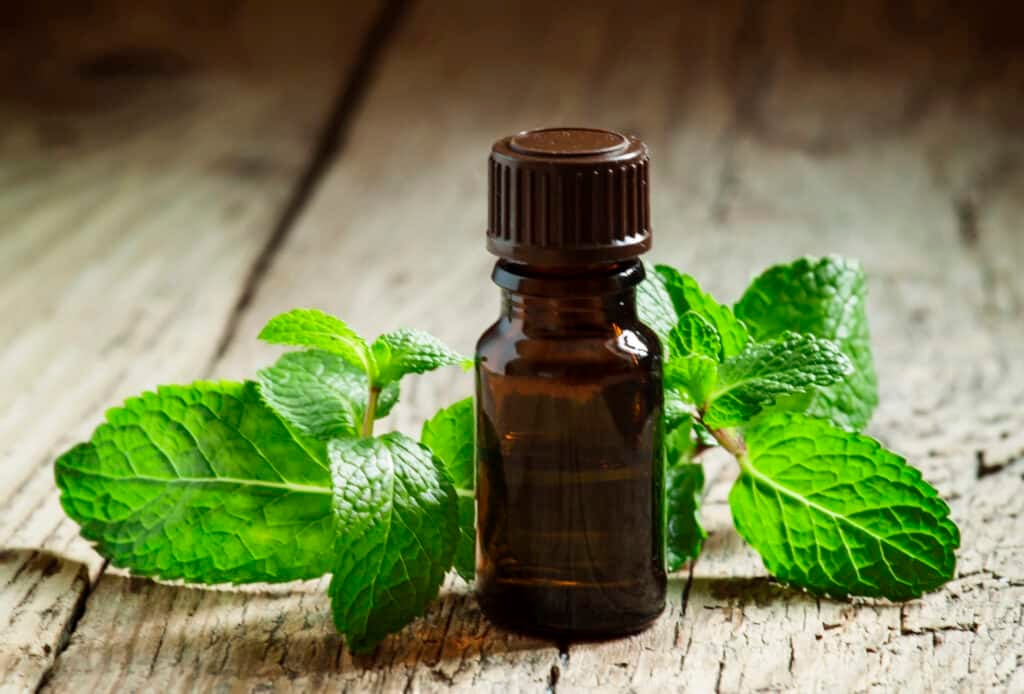
Peppermint oil gets the hype for a reason. It’s refreshing, and that cooling feel can be a lifesaver when your scalp is dry or itchy.
Beyond sensation, its benefits include antimicrobial effects, insecticidal and pesticidal activity, analgesic and anesthetic qualities, and both vasodilating and vasoconstricting actions. That combination can perk up circulation in short bursts while calming irritation.
A few practical routes:
- Add 2 to 4 drops to a palmful of shampoo on wash day to help with buildup and that tight scalp feeling.
- Make a targeted scalp mixture, 1 ounce grapeseed carrier oil with 5 to 7 drops peppermint. Massage gently and avoid the eye area. Trust me on the eye part.
If your scalp tingles to the point of discomfort, dilute further. More is not better with peppermint. I learned that the hard way.
Rosemary Essential Oil For Hair

Rosemary oil is my pick for endurance. It has a nourishing effect that can help hair feel more resilient and less prone to breakage; when you lose fewer weak strands to snapping, hair appears stronger.
There’s also evidence to suggest that this EO can actually promote hair growth. Over months, that can look like more density at the roots and a little more swing in your ponytail.
What works in my routine:
- A weekly rosemary pre-wash: 1 ounce of olive oil, 8 drops rosemary. Massage in, wait 30 minutes, shampoo twice.
- On rushed weeks, I’ll use a rosemary, lavender, peppermint trio at very low percentages in a light leave-in. Two or three drops total to 2 ounces of aloe and glycerin conditioning base.
I once tried a rosemary water spritz and left it on all day. It made my hair smell like a herb garden, which was pleasant, but my ends felt tacky. Oil infusions or diluted essential oils in proper carriers give me better results.
Tea Tree Essential Oil For Hair
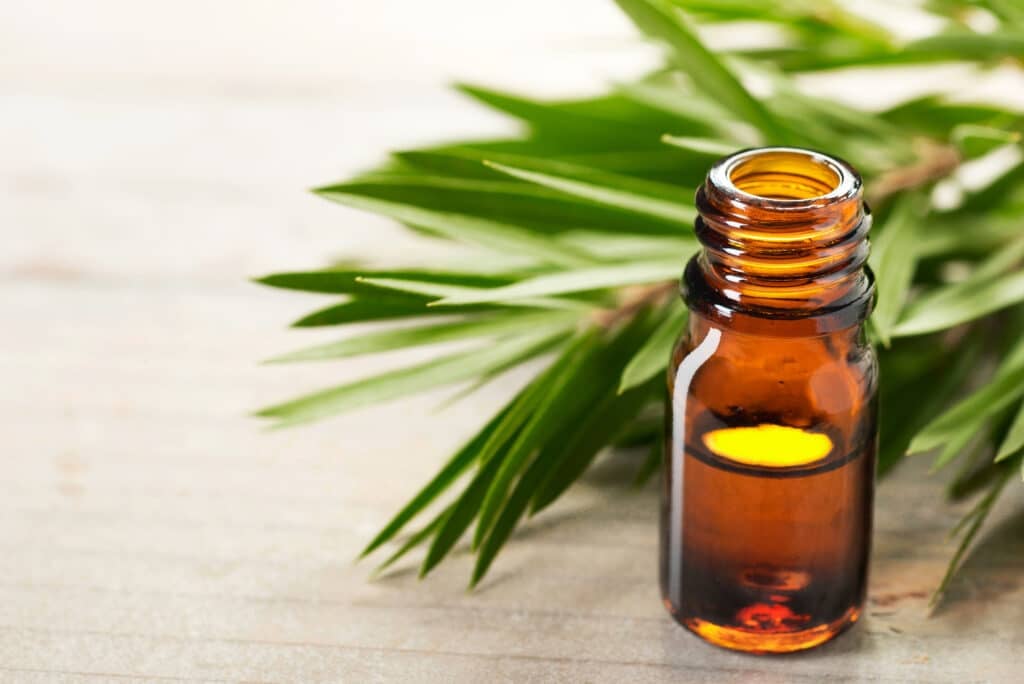
Tea tree oil is the one I keep for scalp emergencies. If you deal with dandruff, you know the cycle, flakes, itch, scratch, more flakes. Tea tree oil can help with various scalp conditions, including dandruff, partly thanks to its antiseptic properties and broad antimicrobial profile.
Using shampoos with harsh detergents can strip follicles of what they need; frequent dyeing or heavy styling products can also leave hair brittle, even falling out more than usual. Adding a small amount of diluted tea tree oil to your homemade shampoo can help reduce buildup of product and dead skin so your hair can grow without unnecessary breakage.
Two easy ways:
- Mix 6 drops tea tree into 1 ounce of jojoba or sweet almond carrier oil. Massage before washing.
- Or add 2 drops to a single use of shampoo in your palm and lather at the scalp only. Rinse, then condition mid-lengths and ends.
If you’re managing scalp psoriasis, keep tea tree in your toolkit as an occasional assist between medical treatments, and listen to your dermatologist first.
Other Alternatives For Natural Hair Growth Oil
Essential oils are concentrates, but the base matters just as much. If your hair leans dry, coconut oil or olive oil can be excellent carriers, they help reduce protein loss from the hair shaft. Jojoba mimics natural sebum, so it suits oily or easily congested scalps. Grapeseed is light and fast.
You can also go the old-school route with herb-infused oils. Think rosemary leaves steeped in olive oil, strained, then used as a carrier for a drop or two of lavender. It smells grounded, and the slip is gorgeous.

Castor oil is popular for hair growth; I find it too heavy solo, but a teaspoon swirled into lighter carriers adds nice cushion. Pumpkin seed oil is another favorite, a touch nutty, and friendly to fragile ends.
Beyond oils, caffeine scalp serums, gentle scalp exfoliation once a week, and regular massage help. Not exotic, just consistent. And if you’re experiencing sudden hair loss or patchy thinning, talk to a professional to rule out telogen effluvium and other conditions. Topicals are helpful, medical insight is essential.
Risks and Potential Complications
Let’s be super clear about safety. Essential oils can cause nasty irritation and allergic reactions if you use them undiluted, or at high percentages. Reactions range from redness and itching to dermatitis, burning, or even blisters. Definitely something we need to avoid when formulating our own hair care products.
Citrus oils can increase photosensitivity, so if you use lemon, bergamot, or similar on hair or scalp, be mindful of sun exposure. There are also special cases, pregnancy, breastfeeding, and young children call for caution or avoidance with many oils. When in doubt, skip it.
Although it’s worth noting that you can get safe version of these essential oils, usually extracted with a steam distillation method rather than mechanical expression (often just labelled as ‘expressed’). Look for ‘distilled’ on the labels. Furthermore, there are many citrus essential oils that aren’t phototoxic at all, such as orange or grapefruit essential oils.
Overuse can backfire. A stressed scalp can respond with increased shedding, and in some people, aggressive routines might nudge telogen effluvium. More product won’t fix hair loss related to hormones, illness, or nutrient deficiencies. Match the tool to the task.
Three safety rules I live by:
- Always dilute in a carrier oil. For scalp use, 1 percent is a good place to start, roughly 6 drops total essential oil per ounce of carrier. For hair lengths, 1 to 2 percent is plenty.
- Patch test on the inner arm or behind the ear for 24 to 48 hours. No shortcuts here.
- Store oils tightly capped, away from heat and light. Oxidized oils are more irritating, and no one wants that.
How to Use Essential Oils for Hair Care
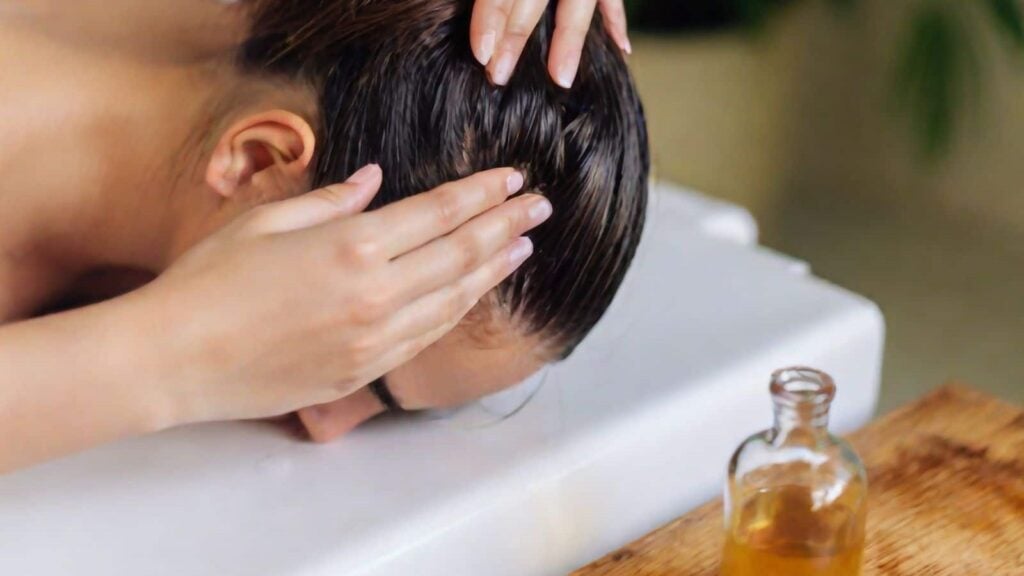
Here’s a simple routine that respects your scalp and gives you wiggle room to customize. It’s not fussy; it works.
1. Build a base, pick a carrier oil
- Oily or easily clogged scalp, jojoba or grapeseed.
- Dry hair or coarse texture, olive oil or coconut oil.
- Mixed scalp, blend jojoba and a splash of castor.
2. Choose your focus oil
- For growth support and calm, lavender.
- For freshness and shine, lemongrass.
- For itch relief, peppermint.
- For resilience and less breakage, rosemary.
- For dandruff and buildup, tea tree oil.
3. Mix it, lightly
In 1 ounce of carrier oil, add 6 to 12 drops total essential oils, depending on your tolerance and whether it is a scalp or mid-length treatment. Shake or swirl. The mixture should smell pleasant, not sharp.
4. Massage, then wash
Apply to the scalp with fingertips. Small circles, light pressure. Two minutes is enough. Leave on for 15 to 30 minutes. Shampoo the scalp, condition the lengths. If you prefer, add a couple drops of your chosen oil to your conditioner instead and leave it on for a minute or two in the shower. Both routes work.
5. Frequency
Start once a week. If your scalp is happy, try twice weekly. Track how your hair behaves for a month. I keep notes in my phone, nothing fancy.
6. Little Extras
- A tiny amount, a pea-sized dab of your oil mixture, smoothed over ends on damp hair can tame frizz.
- If you love aromatherapy, warm a towel, spritz with water, and wrap for five minutes after your scalp massage. It feels luxurious for no good reason. Or maybe that’s the point.
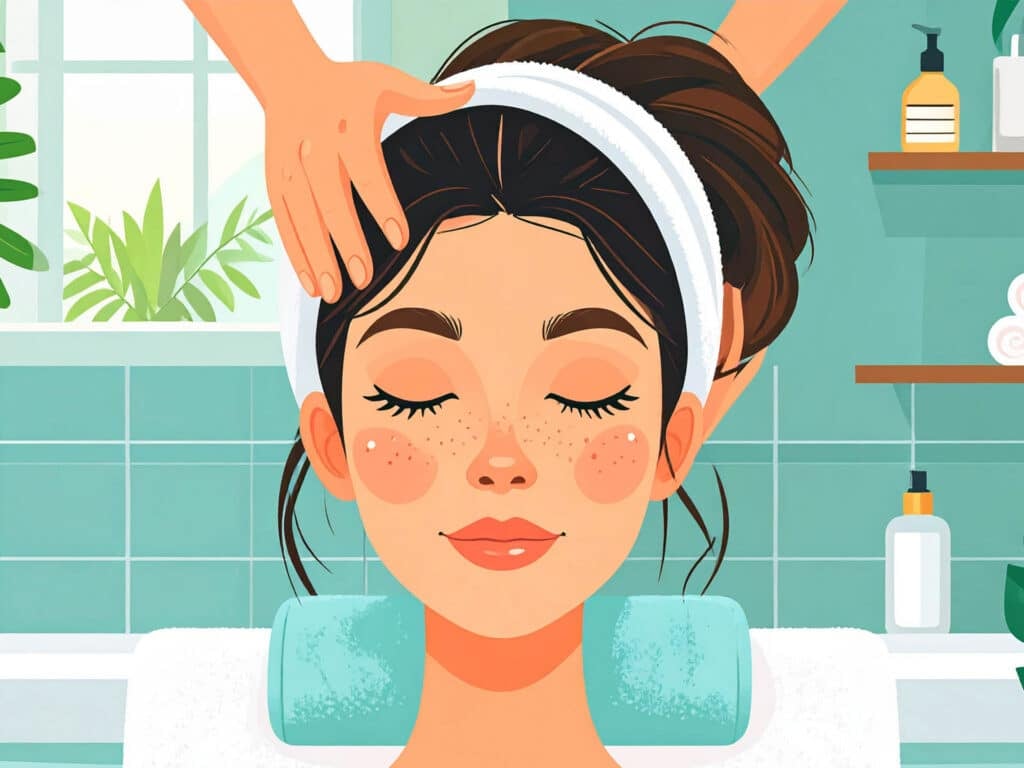
While we’re on the topic, watch your shampoo. Harsh surfactants and constant dyeing can strip your hair and leave it vulnerable to breakage. Swapping to a gentler shampoo and spacing out color sessions will make any oil routine more effective. I learned this after my “fix everything with tea tree” phase. Tools are tools. Habits carry you.
Final Thoughts
Essential oils for hair can help in three practical ways, better scalp health, stronger strands, and supported growth.
Lavender helps with growth and dandruff. Lemongrass strengthens follicles and adds glossy sheen.
Peppermint soothes dryness and itching, with antimicrobial and anti-inflammatory benefits. Rosemary nourishes for resilience, cutting back on breakage so hair appears stronger.
Tea tree oil helps with dandruff and buildup, especially when you add a little to shampoo or use a properly diluted pre-wash.
They’re concentrated ingredients, so keep your routine simple, dilute in a carrier oil, patch test, and go gentle if you’re pregnant or caring for young kids. Combine the oils with smart basics, good shampoo and conditioner choices, consistent massage, and rest days from heat styling. Maybe it’s just me, but the hair wins you get from that mix feel earned, not accidental.
Recently I shared the best essential oils for soap making with my top 10 picks, safety guidelines, and blending tips to craft long-lasting, great-smelling soap bars. Take a look if you’re interested in making your own soap


